 Yes, you may still be able to file a personal injury claim even if you were jaywalking when struck by a vehicle. Many pedestrians assume that crossing outside of a designated crosswalk automatically bars them from seeking compensation, but Texas law allows for a more complex analysis of fault and liability in these situations.
Yes, you may still be able to file a personal injury claim even if you were jaywalking when struck by a vehicle. Many pedestrians assume that crossing outside of a designated crosswalk automatically bars them from seeking compensation, but Texas law allows for a more complex analysis of fault and liability in these situations.
At Byrd Davis Alden & Henrichson LLP, we have successfully represented jaywalking accident victims for over 65 years throughout Texas. Our experienced attorneys understand how Texas comparative negligence laws work and fight to ensure you receive fair compensation even when you may share some responsibility for the accident.
Understanding Texas Comparative Negligence Laws
Texas follows a modified comparative negligence system, which means you can recover damages even if you were partially at fault for your accident. Under this system, your compensation is reduced by your percentage of fault, but you can still recover damages as long as you are less than 51% responsible for the incident.
For example, if a court determines you were 30% at fault for jaywalking while the driver was 70% at fault for speeding or texting, you could still recover 70% of your total damages. However, if you are found to be 51% or more at fault, you cannot recover any compensation under Texas law.
How Fault Is Determined in Jaywalking Cases
Determining fault in jaywalking accidents requires careful analysis of multiple factors beyond simply crossing outside a crosswalk. Courts consider the driver’s behavior, road conditions, visibility, and whether both parties had reasonable opportunities to avoid the collision.
Drivers have a fundamental duty to exercise reasonable care and watch for pedestrians, even those who may be crossing illegally. If a driver was speeding, distracted, under the influence, or failed to brake when they could have avoided the accident, they may bear significant responsibility regardless of your jaywalking.
Common Driver Negligence in Pedestrian Accidents
Even when pedestrians jaywalk, drivers frequently contribute to accidents through their own negligent behavior. Understanding these factors is crucial for building a strong case and maximizing your compensation.
Distracted Driving and Failure to Maintain Proper Lookout
Many pedestrian accidents occur because drivers fail to maintain proper attention to the road. Distracted driving behaviors such as texting, talking on phones, adjusting GPS systems, or eating while driving significantly increase the risk of striking pedestrians, even those crossing legally in crosswalks.
Drivers have a legal obligation to maintain a proper lookout for pedestrians and other hazards. When drivers fail to scan their surroundings or become fixated on other tasks, they may not see jaywalking pedestrians in time to stop, even when they have adequate distance to do so.
Excessive Speed and Aggressive Driving
Speed plays a critical role in both the likelihood of pedestrian accidents and the severity of resulting injuries. Drivers traveling above the speed limit have less time to react to unexpected situations and require greater distances to stop safely.
In urban areas where jaywalking is more common, reasonable drivers should anticipate the possibility of pedestrians crossing unexpectedly and adjust their speed accordingly. Drivers who maintain excessive speeds in areas with high pedestrian traffic may bear substantial responsibility for accidents, even when pedestrians were jaywalking.
Damages Available in Jaywalking Accident Cases
Texas pedestrian accident victims can recover various types of compensation, even when they share fault for the incident. The key is demonstrating that your damages exceed any reduction based on comparative negligence principles.
Economic damages include medical expenses for emergency treatment, surgeries, rehabilitation, and ongoing care. You may also recover lost wages during your recovery period and compensation for reduced earning capacity if your injuries affect your ability to work long-term. Property damage to personal belongings such as phones, clothing, or bags is also recoverable.
Non-economic damages address the personal impact of your injuries, including physical pain and suffering, emotional distress, loss of enjoyment of life, and permanent disability or scarring. In cases involving particularly egregious driver conduct, punitive damages may also be available to punish defendants and deter similar behavior.
Why Choose Byrd Davis Alden & Henrichson, LLP for Your Jaywalking Accident Case
Jaywalking accident cases require skilled legal representation to overcome insurance company arguments about shared fault and contributory negligence. As Austin’s oldest personal injury law firm, established in 1959, we have the experience and resources to thoroughly investigate your case and build compelling arguments for maximum compensation.
Our trial attorneys have successfully recovered over $100 million for our clients and maintain a 98% success rate in personal injury cases. We understand how to gather evidence, work with accident reconstruction specialists, and counter insurance company tactics designed to minimize your recovery. Insurance companies know our reputation for courtroom success, often leading to favorable settlements without lengthy trials. We handle all cases on a contingency fee basis, so you pay no attorney fees unless we win your case. Contact us at (512) 454-3751 or through our contact form to discuss your jaywalking accident claim with our experienced legal team.





